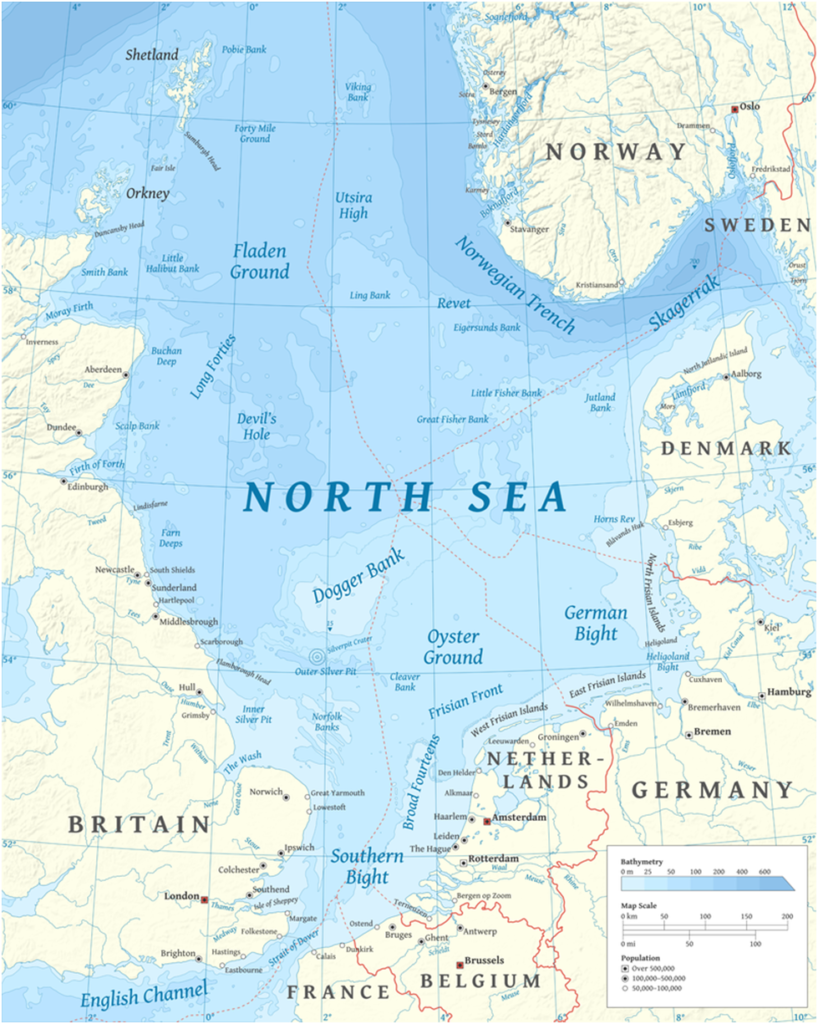North Sea is a shallow, northeastern arm of the Atlantic Ocean, located between the British Isles and the mainland of northwestern Europe.
It hosts key north European shipping lanes and is a major fishery. The coast is a popular destination for recreation and tourism in bordering countries, and a rich source of energy resources, including wind and wave power.
Must read: Geography of Mediterranean Sea
Extent and borders of North Sea
The North Sea is bordered by the island of Great Britain to the southwest and west, the Orkney and Shetland islands to the northwest, Norway to the northeast, Denmark to the east, Germany and the Netherlands to the southeast, and Belgium and France to the south.
It is connected to the Atlantic by the Strait of Dover and the English Channel in the south.
It connects to the Atlantic Ocean through the Norwegian Sea in the north.
In the east, it connects to the Baltic Sea via the Skagerrak and Kattegat narrow straits that separate Denmark from Norway and Sweden respectively.
It is more than 970 kilometres long and 580 kilometres wide.

Area of North Sea
The North Sea occupies an area of approximately 570,000 square kilometres.
Depth of North Sea
The North Sea has an average depth of 95 m.
Coastal landforms of North Sea
The coast of North sea has diverse geology and geography. In the north, deep fjords and sheer cliffs mark much of its Norwegian and Scottish coastlines respectively, whereas in the south, the coast consists mainly of sandy beaches, estuaries of long rivers and wide mudflats.
Islands of North Sea
Around the edges of the North Sea are sizeable islands and archipelagos, including Shetland, Orkney, and the Frisian Islands.
Dogger Bank
Dogger Bank is a large sandbank in a shallow area of the North Sea about 100 kilometres off the east coast of England. The water depth ranges from 15 to 36 metres.
It has long been known by fishermen to be a productive fishing bank; it was named after the doggers, medieval Dutch fishing boats especially used for catching cod.
Rivers flowing into North Sea
The North Sea receives freshwater from a number of European continental watersheds, as well as the British Isles. A large part of the European drainage basin empties into the North Sea, including water from the Baltic Sea. The largest and most important rivers flowing into the North Sea are the Elbe and the Rhine – Meuse.
Environmental issues
Due to the dense population, heavy industrialisation, and intense use of the sea and the area surrounding it, various environmental issues affect the sea’s ecosystems. Adverse environmental issues – commonly including overfishing, industrial and agricultural runoff, dredging, and dumping, among others – have led to several efforts to prevent degradation and to safeguard long-term economic benefits.
External link: https://en.wikipedia.org/wiki/North_Sea
PRACTICE QUESTIONS
QUES . Consider the following countries : UPSC 2024
1 . Finland
2 . Germany
3 . Norway
4 . Russia
How many of the above countries have a border with the North Sea?
(a) Only one
(b) Only two
(c) Only three
(d) All four
Ans (b) EXPLANATION: Germany and Norway. The North Sea is bordered by the island of Great Britain to the southwest and west, the Orkney and Shetland islands to the northwest, Norway to the northeast, Denmark to the east, Germany and the Netherlands to the southeast, and Belgium and France to the south.
